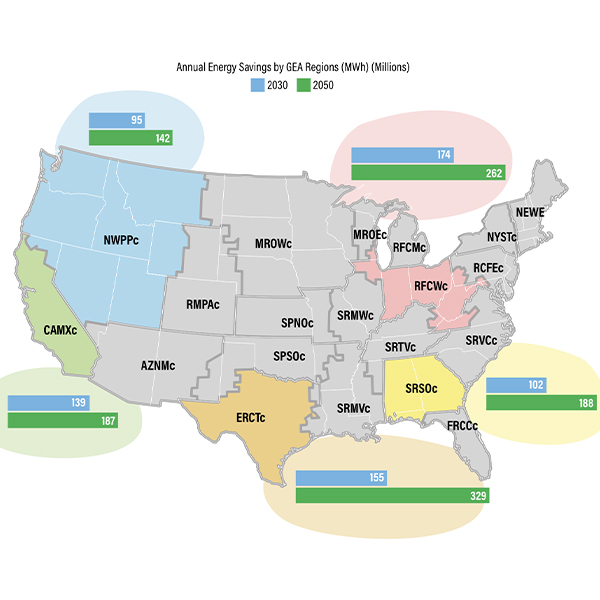
The American Council for an Energy-Efficient Economy released a report Wednesday finding that increasing efficiency would help avoid most of the annual load that must be met with non-renewable resources on a net-zero-emissions grid, even without widespread electrification.
“While the role of energy efficiency is well established in global and economy-wide decarbonization efforts, its value proposition is positioned to change as the electricity consumption it offsets decarbonizes,” the report said. “Because solar and wind are carbon-free energy sources, energy efficiency has been perceived by some as a less valuable decarbonization tool in a high renewable energy future.”
Efficiency can offset between 31 to 46% of net peak load by 2030 and 39 to 86% by 2050, varying between the five regions studied in the report, called “Energy Efficiency in a High Renewable Energy Future.”
“These results hold regardless of the speed of renewable energy deployment, though we find that energy efficiency is likely to be more valuable in avoiding total electricity system costs under a more rapid supply-side decarbonization scenario,” the report said.
Efficiency measures that affect thermal space conditioning loads (heating and cooling) are likely to have the greatest impact on both energy savings and avoided costs through 2050, the report said.
The resource could prove especially valuable for low-income housing, which often is inefficient, and low-income consumers face a higher burden in paying for energy, which can be mitigated by using less overall.
The paper included a review of literature around decarbonizing the grid and found some of those focused on the supply-side alone, ignoring efficiency. However, those that do include the resource list it as among the most important tools needed to meet decarbonization goals.
“Our modeling finds that energy efficiency measures reduce burdens on the power sector, avoiding billions of dollars’ worth of energy and capacity costs in 2030, and two to three times as much in 2050 even with high deployment of renewable energy,” the report said. “We estimate that by 2050 annual power sector savings will range between $10 billion and $19 billion per grid region analyzed.”
The study specifically modeled California, Texas, the Southeast, Midwest and Northwest, using two renewable energy scenarios: one with electric sector decarbonization by 2050, and another where the job is mostly done by 2035.
Examples of energy-efficient interventions include improving a building’s thermal envelope through insulation and other weatherization techniques, upgrading heating and cooling systems, installing smart thermostats, converting to heat pumps and upgrading appliances. The report looked into 12 efficiency measures and found that thermal envelope improvements would be the most impactful.
The impact of improving buildings’ thermal envelopes varies by region and has the biggest impact in areas with lower baseline energy codes, lower-quality existing building stock and more extreme temperatures, which the study said includes Texas and the Southeast.
“To maximize electricity system benefits through demand-side interventions, utilities should prioritize thermal space conditioning measures within their portfolios,” the paper said. “Replacing low-performance air source heat pumps or electric furnaces with high-performance air source heat pump models will guarantee savings and lower demand on the grid.”
Getting energy-efficient equipment in place often has a limited window around when customers are replacing old equipment, so the paper recommended that educational materials be rolled out well before then so they are aware of the options when the time comes.
The commercial sector has tremendous potential for efficiency, with the paper suggesting utilities have programs that have robust integrated efficiency offerings for them that deal with heating, cooling, ventilation, insulation, lighting and energy-management systems.
The report’s literature review found that many studies do not compare efficiency’s demand-side impacts along with the supply-side resources such as solar, wind or natural gas.
“Consequently, energy efficiency measures do not emerge from least-cost energy system optimizations as a resource of choice, which may reduce their procurement,” the paper said. “Capacity expansion models should therefore ensure that all supply- and demand-side resources are fairly compared against each other, and not marginalized by default.”

